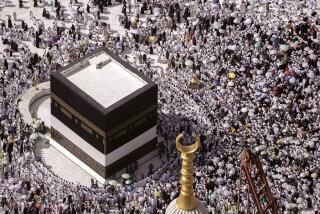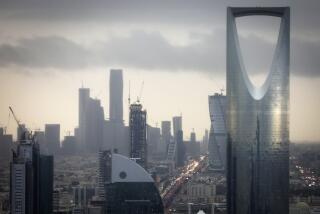Cairo’s Poor Fear Eviction as Urban Renewal Arrives
- Share via
CAIRO — Cairo could use a face-lift, and Al Azhar Park, with its lawns, flowers and fountains built on a 500-year-old hill of garbage, sounds like a great beginning.
But while many neighbors are full of compliments, Nabiya Hussein is suspicious. She fears gentrification will mean her eviction from the illegally built apartment where she has lived for 30 years, because it’s next to one of the park’s entrances, and she knows that it’s an eyesore.
“I’m scared that if I leave for the repairmen to come in, I won’t have a home to come back to, because they will demolish it to serve their interests,” the mother of two said.
Such suspicions are rampant in the Darb al Ahmar slum, underlining the challenge that urban renewal faces in one of the world’s oldest, most congested cities.
On one side is Darb al Ahmar, which means “the Red Road,” where 200,000 people live. It hugs the 12th century Ayyubid Wall, which once surrounded the city to keep out invaders and was buried in tons of rubbish before the cleanup began.
Towering above the other side of the wall is the $30-million, 74-acre Al Azhar Park, to be inaugurated March 25 as a gift to Cairo from the Aga Khan, spiritual leader of the world’s 20 million Ismaili Muslims whose ancestors, the Fatimids, ruled Cairo between 908 and 1187 A.D.
But since work began in 1997, it has been a tough sell.
“This type of work is very foreign and alien to the community,” said Mohammed Mikawi, executive manager of the Aga Khan’s Cairo operations. “People obviously ask why a private organization would do this kind of volunteer work. Why would someone build this park?”
The answer, Mikawi said, is simple: The Aga Khan, whose development work stretches from India to East Africa, is determined to help the poor, and “we ... are starting to get our message across.”
But it’s hard convincing some of Cairo’s poorest, who are not accustomed to getting government or private aid. It’s also hard to get people raised in noise and squalor to respect the tranquillity and wildlife in the park.
A man walks by with an uprooted sapling from the park slung over his shoulder. A guard tells of kids trapping an ibis and beating the bird to death.
Hand-in-hand with the park, the Aga Khan has tried to revitalize one of Cairo’s poorest neighborhoods by starting public health centers, renovating buildings and providing small business loans.
Mikawi says such work will continue for four more years under an $11-million program by the Aga Khan and the German Development Bank to run clinics, restore 150 neighborhood houses and educate children.
“The Aga Khan’s work here is beautiful and has turned many negatives into positives,” said Sayid Mustafa Ahmed, who makes leather bags. He employs 20 people, up from two since receiving loans from the Aga Khan.
“But unfortunately, many people are suspicious of his intentions. Maybe it is because of ignorance, or that information about the project is not given properly to the people,” he said.
Fawzia Abdel Latif, 45, lives in a five-story building by the ancient wall that the Aga Khan organization worked on for a year.
“The Aga Khan has done more for the people in Darb al Ahmar than the government has,” she said. She also wonders why he bothers, but added: “Without him, we’d have no home.”
In a tiny lane in the shadow of the Ayyubid Wall, 22 people from five families live side-by-side in sweltering two-room apartments with a single kitchen and no running water.
Anaim Abd Badigah, 48, has lived in this lane all her life. She says Aga Khan engineers plan to expand the homes by grinding away several inches from the interior walls to provide more space.
“I feel suffocated here,” Badigah said, handing cups of sweet tea to her visitors. “All I pray for is for God and the Aga Khan to make this room a little bigger and help my children to marry. I need nothing else.”
More to Read
Sign up for Essential California
The most important California stories and recommendations in your inbox every morning.
You may occasionally receive promotional content from the Los Angeles Times.













